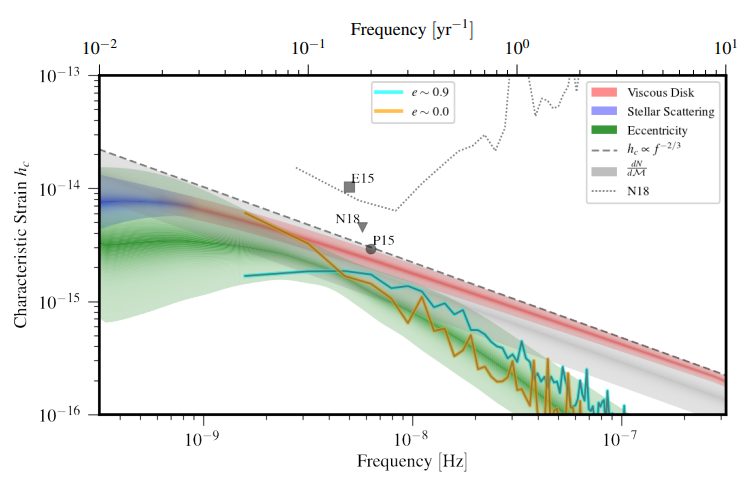TL;DR: We do have gravitational wave emission from supermassive black hole binaries (SMBHBs) at larger separations, but a background created from solely those binaries won't have the characteristic shape or cover the frequency ranges we both expect and observe it to have.
As a preface, there are numerous theoretical solutions to the final parsec problem, as mentioned by Agazie et al. 2023a, the astrophysical interpretations paper (see this nice answer on Physics Stack Exchange for a quick overview of the state of the problem). We don't know what the right explanation is, but both existing observational evidence and more sophisticated theoretical modeling show that, well, nature has found a way to solve it, and the problem might not be a problem at all. The new pulsar timing array results support that point even more.
First off, there are several different separation regimes, where different environmental processes dominate the evolution of the binary through hardening, decreasing its semimajor access (Taylor 2021). The different separations also mean we expect them to be important at different frequency ranges.
- Kiloparsecs to parsecs: Dynamical friction, the "drag" acting on a binary from an ensemble of stellar scattering events in the aftermath of a galaxy merger. This contributes no significant shape to the gravitational wave spectrum.
- Parsecs: Stellar loss-cone scattering of individual stars near the core. This contributes a strain scaling with frequency as $h_c(f)\propto f$.
- Centiparsecs to milliparsecs: Viscous interaction with a circumbinary disk. This can produce a variety of strain contributions from $h_c(f)\propto f^{-1/6}$ to $h_c(f)\propto f^{1/2}$.
- Milliparsecs and below: Gravitational wave emission. At this point, the inspiral is driven by nanohertz gravitational waves, producing a strain scaling as $h_c(f)\propto f^{-2/3}$. This is expected to be the (effectively) sole contribution to the gravitational wave background at the frequencies pulsar timing arrays are sensitive to. The power spectral density (PSD) then goes like $\Phi(f)\propto h_c(f)^2/f^3\propto f^{-13/3}$. You might have heard "13/3" mentioned as a key characteristic of the (idealized!) GWB; this is where that scaling comes from.
Here's a nice plot showing some of these contributions, Fig. 4 of Burke-Spolaor et al. 2019:

In short, we expect to see some contributions at lower frequencies from loss-cone scattering and disk interaction before gravitational wave emission takes over completely at frequencies around a few nanohertz. The different environmental mechanisms act at different frequency ranges and provide different shapes.
The question, then, is how the power spectral density actually scales in the NANOGrav data. The answer: not quite as $\Phi(f)\propto f^{-13/3}$, but it's not obscenely far away. Here are the two big plots showing the results of a power law analysis (Fig. 1a and 1b, Agazie et al. 2023b). Note that much of the plot is at frequencies above a few nanohertz, and therefore where GW emission should drive the inspiral:

The top plot shows both posteriors for the free spectrum fit -- i.e. allow $\Phi(f)$ to scale as $f^{-\gamma}$ for any $\gamma$ -- in blue, and a fit to a power law forcing $\gamma=13/3$, in black. The bottom plot shows joint and individual posteriors for the spectral index and the GWB amplitude. You can see that a shallower power law is favored over our idealized GWB. $\gamma=13/3$ is within the $3\sigma$ confidence region, but there's still a noticeable difference. Still, the posterior is definitely not consistent with the mechanisms driving evolution on the scale of parsecs.
So, yes, the strain doesn't scale the way we'd expect for our GWB where gravitational wave emission is the sole driver of the inspiral. However, $\gamma=13/3$ just represents the idealized model of gravitational wave emission at those milliparsec scales, and it's entirely possible -- likely, really -- that there are other environmental factors contributing to the inspiral and yielding a shallower power law. You can also tweak the population parameters and get something consistent with the spectral index and amplitude we see (and Agazie et al. 2023a talks about these a lot).
If you were able to construct a population of binaries at separations on the order of a parsec and crank up the GWB amplitude by manipulating your population parameters just right, you'd might end up with a GWB with an amplitude at a few nanohertz comparable with what NANOGrav found. Loss-cone scattering, however, would mean you'd still be stuck with a power spectral density scaling as $\Phi(f)\propto h_c(f)^2/f^3\propto f^2/f^3=f^{-1}$. A glance at the posterior for $\gamma$ indicates we can firmly rule that out.
The bottom line: Even with the slight mis-match between $\gamma=13/3$ and what the NANOGrav results show, you can still reproduce the data reasonably well with adequate population models, and you can't do it with just a bunch of binaries at parsec-scale separations. Even "new physics" models (Afzal et al. 2023), which actually reproduce the spectrum quite well, are way more compelling.

